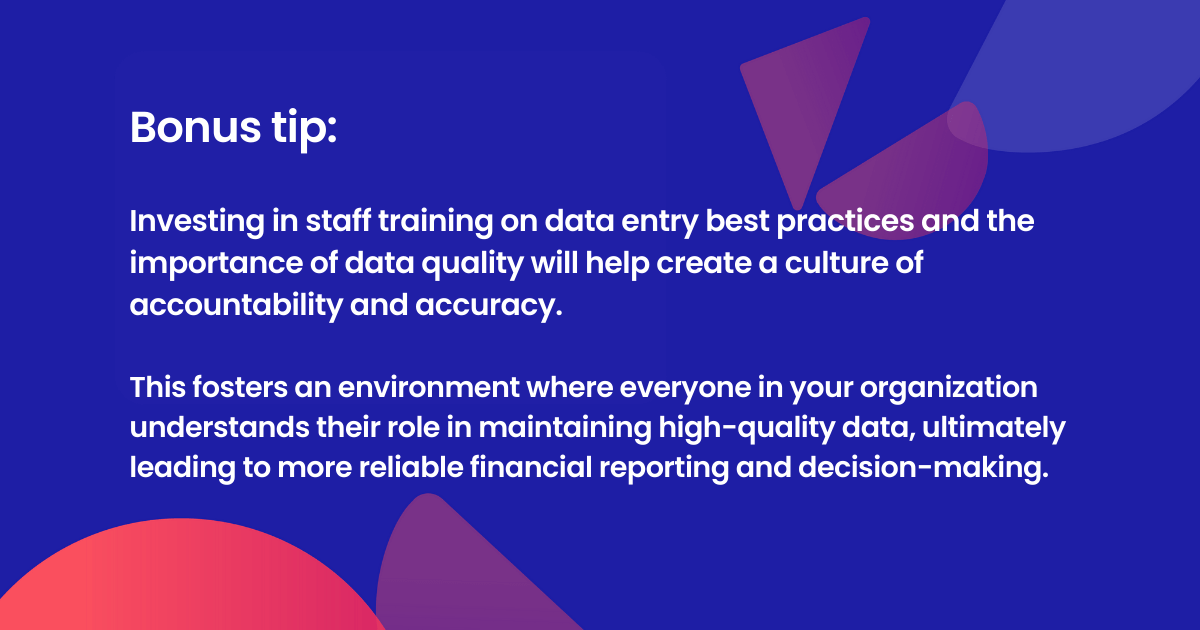Data management plays a pivotal role in driving insightful decisions and ensuring the financial success of a company. But let's face it – navigating this intricate landscape can feel like a battle, filled with data management challenges like inaccuracies, security breaches, and complex integrations.
In fact, Gartner's research reveals that 54% of finance organizations still struggle to provide data stakeholders can rely on for informed decision-making.
But what if we told you that for every data management problem, there’s a viable solution to help resolve it?
Keep reading to learn about the most common data management problems and solutions.
Why is it difficult to manage data?
It can be difficult to manage data for many reasons, but the main issue often ties to the large volume of data finance teams work with. Well, that and data quality issues, security nightmares, and insufficient data integration processes.
What causes poor data management?
Poor data management is caused by several factors, including:
- Lack of proper tools and infrastructure
- Insufficient training and expertise
- Disorganized data storage
- Lack of data governance
- Siloed data
The list of reasons doesn’t end there. But what you’ll almost always find is when data management challenges arise, it usually comes down to one of these reasons.
Below, we’ll get into more detail about all of this and explore the main data management problems and solutions.
Data management problems and solutions

1. Problem: Data inaccuracy and quality
Inaccurate and poor-quality data can be the bane of any CFO's existence. It often leads to misguided financial decisions, which is bad news for obvious reasons, but the one your boss will care about most is how it’ll negatively impact the bottom line.
Using inaccurate data can also severely damage your company's reputation. If you can’t provide reliable and accurate financial information, stakeholders will lose confidence in not only you and your capabilities, but in the company as a whole.
The root causes of this data management problem are multifaceted, ranging from human error and system glitches to the sheer volume of data being handled.
Solution: Implement data validation processes
Thankfully, there are practical solutions to tackle these database performance issues head-on. Implementing data validation processes at the point of entry can help minimize errors and ensure data is clean and accurate.
Automated error checks can also help boost data quality by flagging inconsistencies, making it easier to keep on top of them. Another solution is to roll out regular audits to help identify and rectify discrepancies before they snowball into larger problems.
Putting robust processes and systems in place will create a strong foundation for upholding the highest data quality standards. Prioritizing relevant data and streamlining data collection methods can help reduce the chances of errors creeping in. By focusing on what matters most, you can better allocate resources and ensure the accuracy of your organization's financial data.

2. Problem: Tackling data overload and volume
The sheer volume of data companies accumulate can be overwhelming. If you’re in a finance role, it’s likely you could run into some common challenges when managing vast amounts of data, such as:
- Difficulty in identifying relevant information for decision-making.
- Time-consuming manual data processing.
- Increased risk of errors due to data complexity.
These data management challenges can make it difficult to extract valuable insights and make timely financial decisions.
Solution: Strategies for managing data overload and volume
To effectively tackle data overload and volume, consider implementing the following strategies:
1. Prioritize relevant data
Focus on the most critical data elements directly impacting your financial decisions. This helps to reduce the noise and ensures you're working with the most relevant information.
2. Utilize automated data processing
Leverage automation tools to streamline data processing tasks, reducing manual effort, and minimizing the risk of errors. This will free up your team to focus on more strategic tasks.
3. Employ visualization tools
Utilize data visualization software to transform complex data into easily digestible formats, such as graphs and charts. Doing this will help you to quickly identify trends, patterns, and anomalies.

3. Problem: Data silos and integration
Data silos pose a significant challenge for CFOs and organizations, emphasizing the importance of addressing data management problems and solutions.
When data is isolated within separate departments or systems, it can lead to:
- Inefficient decision-making due to incomplete information.
- Duplication of efforts and data inconsistencies.
- Hindered cross-functional collaboration and innovation.
These problems can severely impact your organization's ability to make well-informed financial decisions and hinder overall growth.
Solution: Strategies for breaking down data silos and improving integration
You can combat data silos and promote better data integration by:
1. Promoting data sharing
Encourage a culture of transparency and collaboration by emphasizing the importance of sharing data across departments and teams.
2. Integrating better systems
Invest in technology and tools that enable seamless integration of different data sources, creating a unified and easily accessible data repository.
3. Encouraging cross-functional collaboration
Foster a collaborative environment by setting up cross-functional teams and projects that require data sharing and integration.
4. Problem: Data security and compliance
As financial data often include sensitive information, it’s important to make sure the data is protected from unauthorized access, breaches, and misuse. Focusing on database problems and solutions is crucial because a lack of proper security measures and compliance can lead to a line-up of potential issues, including:
- Financial losses due to fraud, theft, or data breaches.
- Reputational damage resulting from negative publicity and customer mistrust.
- Regulatory fines and penalties for non-compliance with data protection laws and industry standards.
These issues can severely undermine an organization's financial stability and hinder its ability to grow and compete in the market.

Solution: Strengthening data security and ensuring compliance
Here are some ways to address data security and compliance concerns:
1. Implement robust security measures
Invest in advanced security solutions, such as encryption, multi-factor authentication, and intrusion detection systems, to protect sensitive financial data from unauthorized access and cyber threats.
2. Establish clear data policies and procedures
Develop data governance policies that outline the appropriate handling, storage, and sharing of financial data within the company. Don’t forget to make sure the whole team is trained on these policies and adhere to them.
3. Regularly monitor and audit data practices
Conduct regular data security audits and assessments to identify potential vulnerabilities and ensure compliance with industry standards and regulations.
4. Collaborate with IT and cybersecurity teams
Work closely with IT and cybersecurity experts to stay informed about emerging threats and best practices for protecting financial data. Foster a culture of shared responsibility for data security across the entire organization.
We loved this quote from Adam Moloney, CFO at Blancco Technology Group as he emphasizes the importance of collaborating with the IT team to help avoid poor data management.
“Work hand in hand with the IT team to ensure the finance voice is heard in identifying priorities throughout the company’s policy reviews and updates to data security protocols.” - Adam Moloney is CFO at Blancco Technology Group
5. Problem: Data accessibility and governance
Ensuring relevant financial data is easily accessible to authorized personnel, while also maintaining control over its usage, is so important. Failing to do so can lead to:
- Slow and bulky decision-making processes caused by difficulties in accessing relevant data.
- Inconsistent or outdated information being used in financial analyses and reports.
- Increased risk of non-compliance with regulatory requirements and data protection standards.
These challenges can result in poor financial performance. Over time, you also risk weakening your company’s position in the market.
Solution: Enhancing data accessibility and implementing robust governance practices
To tackle these common data management problems and solutions, consider the following strategies:
1. Centralize data storage
Consolidate financial data into a central repository, making it easier for authorized personnel to access and retrieve the information they need for analysis and data-driven decisions.
2. Implement role-based access controls
Define clear roles and permissions for data access, ensuring employees can access only the data relevant to their job responsibilities. This helps maintain data security and minimizes the risk of unauthorized access.
3. Establish data governance frameworks
Develop and implement data governance frameworks outlining data ownership, stewardship, and accountability within the organization. This includes defining data quality standards, data lifecycle management processes, and guidelines for data usage and sharing.
4. Provide training and support
Offer regular training and support to employees to ensure they understand data governance practices and can effectively access and use financial data in their roles.

6. Problem: Resource constraints and skill gaps
In many organizations, finance professionals face resource constraints and skill gaps, which can hinder their ability to effectively manage and analyze data.
Insufficient resources and a lack of expertise in data management can lead to the following issues:
- Inability to leverage advanced analytics and data-driven insights for decision-making.
- Poor data quality, resulting in unreliable financial reports and analyses.
- Increased risk of non-compliance with regulatory requirements and industry standards.
These challenges can limit your ability to compete and grow in an increasingly data-driven business environment.
Solution: Addressing resource constraints and closing skill gaps
To overcome resource constraints and skill gaps, think about:
1. Investing in training and development
Provide ongoing training and development opportunities for finance professionals, equipping them with the necessary skills to manage, analyze, and draw insights from financial data.
2. Leveraging technology and automation
Adopt advanced data management tools and technologies that automate manual tasks, improve data quality, and allow finance professionals to focus on more strategic and value-added activities.

7. Problem: Data automation and structuring unstructured data
A significant portion of financial data exists in unstructured formats, such as emails, documents, and reports. Extracting valuable insights from this unstructured data can be a daunting task.
Not to mention, manual processes and data entry can be time-consuming and prone to errors, leading to data management challenges such as:
- Loss of valuable insights hidden within unstructured data.
- Inefficient use of resources on repetitive and manual tasks.
- Increased likelihood of errors and inconsistencies in financial data.
Solution: Embracing automation and transforming unstructured data
If you want to resolve these issues, here are some possible solutions that can help:
1. Implement data extraction and transformation tools
Utilize advanced tools and technologies, such as natural language processing (NLP) and optical character recognition (OCR), to extract valuable information from unstructured data sources and convert it into structured formats for easy analysis.
2. Adopt Robotic Process Automation (RPA)
Implement RPA solutions to automate repetitive, manual tasks in finance, such as data entry, reconciliations, and report generation. This can improve efficiency, reduce errors, and free up time for more strategic activities.
3. Invest in AI and machine learning technologies
Leverage artificial intelligence (AI) and machine learning (ML) solutions to analyze and process large volumes of structured and unstructured financial data more effectively. These technologies can help uncover hidden patterns, trends, and insights that drive better decision-making.
4. Promote a data-driven culture
Encourage employees to embrace data-driven decision-making by providing them with the necessary tools, training, and support. Foster a culture of continuous learning and improvement, where individuals are empowered to leverage data and technology to drive the organization's success.
Bonus tips
Below, Pat Romano (Director, Finance BI and Strategic Enablement at Dow Jones), shares four bonus tips to help you resolve some of these common data management problems.
"Many of these will remain a challenge if you can't establish some or all of the following:
- Leadership buy-in, engagement, and vision.
2. Clear and collective organizational data strategy to help make the vision become a reality together (not on your own in Finance) and help prioritize what problems to solve first or at all (sometimes good enough or subpar will do based on priorities).
3. Collaboration and partnership between functional leaders and teams - it's hard to move the needle in Finance without partnering heavily with your Finance Tech, CDO, IT, etc leads and teams.
4. If you can afford it.. a dedicated person or team to think about this as part of or their entire role - enables someone to step out of their day-to-day shoes and think about the bigger picture for the greater good of the team/company."
FAQs - Data management challenges
What is a data management system?
A data management system is a set of tools, processes, and practices designed to organize, store, protect, and provide access to an organization's data. It encompasses data storage, data quality, data integration, data security, data governance, and data analytics. A well-designed data management system ensures that data is accurate, consistent, and accessible, allowing organizations to make data-driven decisions and optimize their operations.
Why are database performance issues so common?
Database performance issues are common for several reasons. Some of the main factors include inadequate hardware resources, inefficient database design, poorly optimized queries, and lack of proper indexing.
As organizations grow and their data volumes increase, databases can become more complex, making it challenging to maintain optimal performance. Regular monitoring, optimization, and maintenance are crucial to identifying and resolving performance issues.
What are some quick tips to solve data management problems?
To quickly address data management problems, centralize data storage, implement role-based access controls, and establish data governance frameworks. Regularly monitor and maintain your databases, foster a data-driven culture, invest in data management tools, and provide continuous education and training for your employees. These steps can help you efficiently tackle data management challenges and optimize your organization's data usage.




 Follow us on LinkedIn
Follow us on LinkedIn




